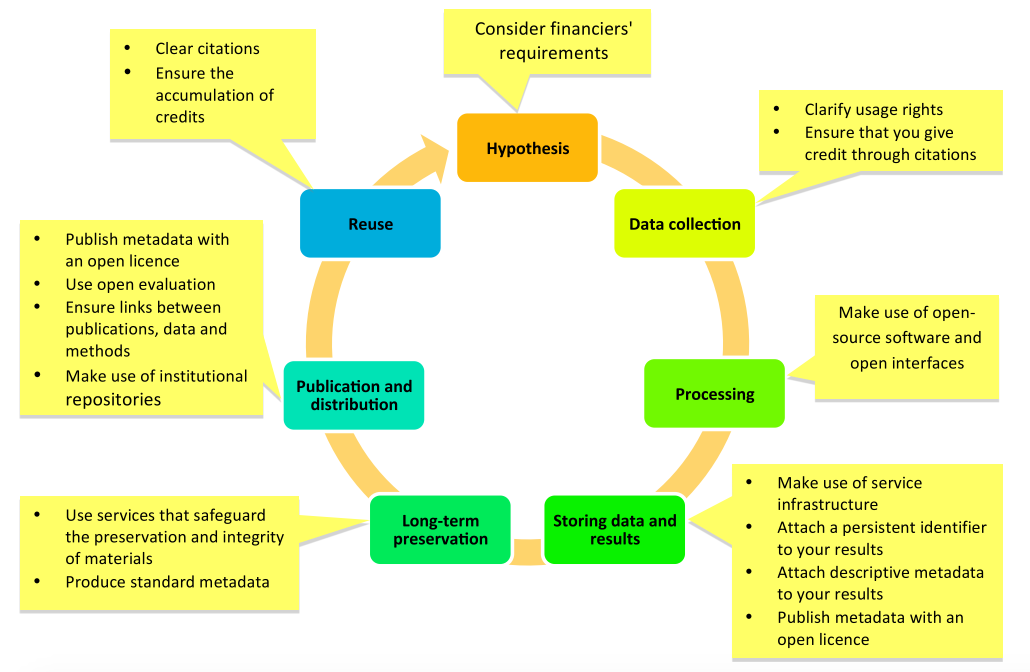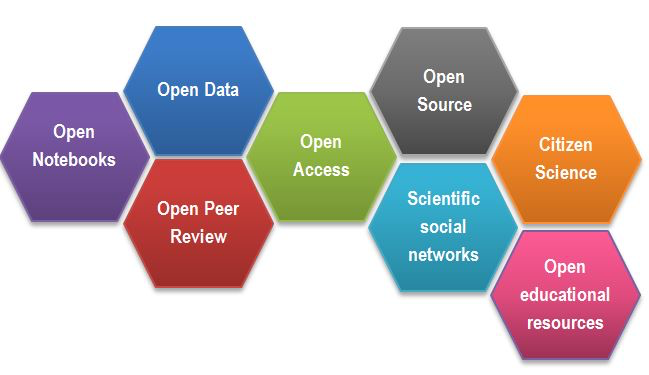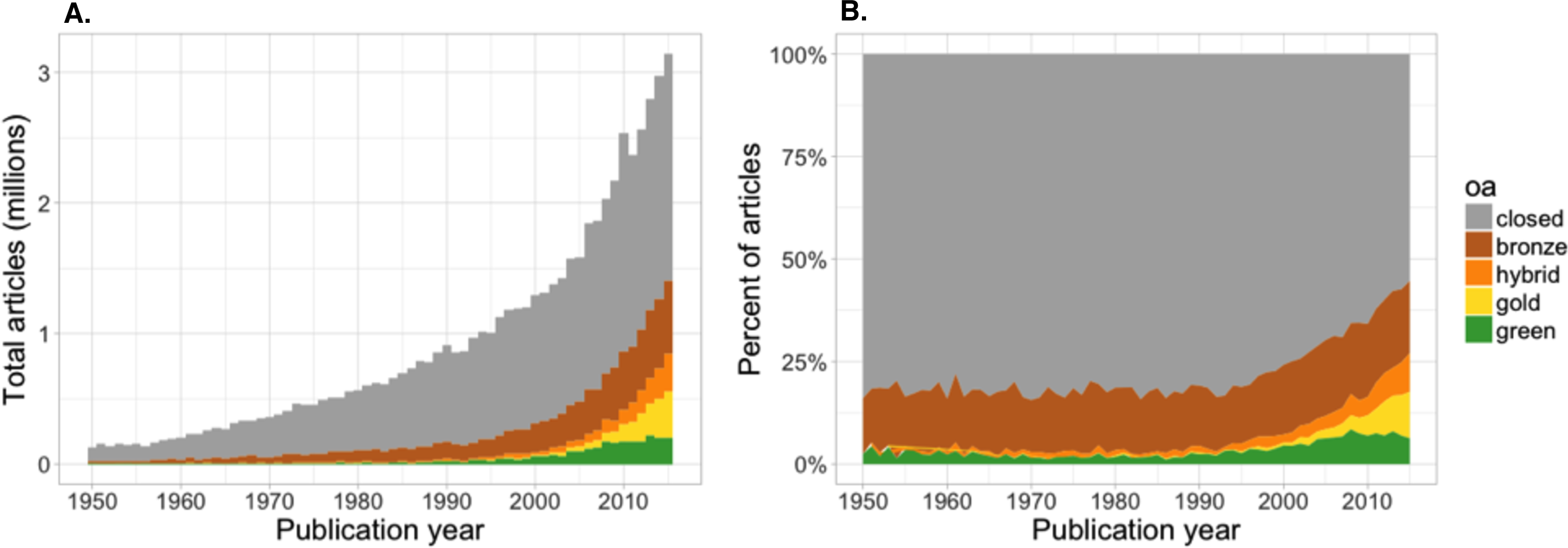About Open Science
The following text has been compiled from many sources of which the following where the prime source of information: Medium article What adopting “open science” means for you and your organization, FOSTER article What is Open Science? Introduction and presentation Setting the default to "open" for research.
Open science can be seen as a new approach to the scientific process based on cooperative work and new ways of diffusing knowledge by using digital technologies and new collaborative tools. Those in turn lead to reduced costs by reducing wasted duplicate effort, better visibility of results, and more ability to reuse work elsewhere. It also can reduce reliance on key personnel and makes organizations more resilient. The OECD defines Open Science as approach: “to make the primary outputs of publicly funded research results – publications and the research data – publicly accessible in digital format with no or minimal restriction”. However, as stated by the FOSTER project, Open Science is more than that and it is extending the principles of openness to the whole research lifecycle (see figure 1), fostering sharing and collaboration as early as possible thus entailing a systemic change to the way science and research is done.
 Figure 1. The research lifecyle. From “The Open Science Handbook” (Open Science and Research Initiative, 2014). Used under the Creative Commons Attribution 4.0 International Public License.
Figure 1. The research lifecyle. From “The Open Science Handbook” (Open Science and Research Initiative, 2014). Used under the Creative Commons Attribution 4.0 International Public License.
Actually 'Open Science' is not a novelty, but according to the UN declaration it is a (basic) human right (see Article 27):
-
Everyone has the right freely to participate in the cultural life of the community, to enjoy the arts and to share in scientific advancement and its benefits.
-
Everyone has the right to the protection of the moral and material interests resulting from any scientific, literary or artistic production of which he is the author.
Open Science is frequently defined as an umbrella term that involves various movements aiming to remove the barriers for sharing any kind of output, resources, methods or tools, at any stage of the research process. As such, open access to publications, open research data, open source software, open collaboration, open peer review, open notebooks, open educational resources, open monographs, citizen science, or research crowdfunding, fall into the boundaries of Open Science (see figure 2). Even though, especially for the library and information domain, the focus is usually placed on two of these movements: Open Research Data and Open Access to scientific publications. Before we make a deep dive into each of the Open Science building blocks lets review the current state of science.

Figure 2. Open Science building blocks (source: FOSTER)
Science must be 'open' per se, however pushing and promoting 'Open Science' principles are needed since according to J. Tennant there are at least four major crisis:
-
Most scholarly research remains inaccessible to most people on this planet as shown in the figure below:

Figure 3. Number of articles (A) and proportion of articles (B) with OA copies, estimated based on a random sample of 100,000 articles with Crossref DOIs. (source: H. Piwowar et all 2018) -
Some study report that at best 50 % of published results can be reproduced.
-
Commercial publishers are basically draining our libraries dry. According to the report subscriptions to journals from commercial publishers is not following the consumer price index, but every year it is becoming significantly higher. Elsevier alone, based on the article from 2015, makes a profit of 25.2 Billion dollar a year from academic publishing business.
-
Globally, Journal Impact Factor (JIF) has been used as a reliable metric to evaluate research articles, their quality. However, JIF was originally designed to aid libraries in deciding which journals to index and purchase for their collections. Therefore, in its structural design JIF is not intended for evaluation of quality of ones work.
As an example lets compare a traditional scientific publishing (e.g., publishing scientific results in one of Elsevier journals, Figure 4) and one that incorporates Open Science principles (e.g., publishing in one of Copernicus journals, Figure 5).

Figure 4. Traditional scientific practices offer almost no open access to scientific work (source: Elsevier logo - Wikipedia provided under fair use license, checkmark icons - Flaticons under specific license which allows non-commercial usage)
In traditional scientific publishing researchers publish scientific paper in high-impact journals which are owned by large publishing companies, which prime drive is profit. These journal have tendency to be closed reviewed (no access to the peer review process) and once a scientific paper is finally accepted and published, there is only a free access to the paper abstract. For the full access to the paper either a reader has to pay (or an entity where the reader works buys a yearly journal subscription) or the author of the paper has to pay an additional (considerable) fee to make his/her work openly available. We could blame large publishing companies for this, however the blame is partially on the authors side as well. The authors have tendency not to share underlying data, neither data processing code nor lab notebooks. There are several reasons for this, that can be summed up with two scenarios that we encounter:
- It is my data and my code, all work I did is mine!
- My data are not properly wrangled and enriched for future reuse, my code is a pure chaos, and notebooks are disorganized
The problem with the first scenario is that usually our research work is publicly funded, and thus, it does not belong to us but to everyone. The second scenario is actually a result of decades of maltreating research outputs other than scientific papers as not important since they are not boosting researchers h-index, thus enabling researchers to advance their careers. Simply there was no incentive to make for example data and code of higher standards other than individual desire to create a long-lasting scientific legacy.
Lets now look at a hypothetical case of applying Open Science principles. First of all, even before we submit a scientific paper for a review, which will eventually result in the paper publication, we are making our lab notebooks available online, for example in a form of blog that is continuously updated as we progress with out work. Once the data collection phase of the research lifecycle is completed we publish metadata of the collected data (this will result in a PID that we can cite). As we are processing we host the data processing code as an open-source repository on for example Github. Integrating Github with Zenodo will assure that we are getting PID (i.e., DOI) for the repository. Benefit of hosting code on Github and integrating Github with Zenodo is that we are also enabling version control of our code, and thus we can cite a specific version of the code. Once goals of data processing are reached, and thus scientific paper written we are submitting the paper to an open-access and open-review journal for example AMT, while publishing the collected data. The submitted paper will contain citations to the online lab notebooks, the collected data and data processing code. One tremendous feature of publishing in open-access/open-review journals is that our paper is accessible and citable right from the moment it enters a discussion phase. Accordingly, everyone has an open access to it as well to all underlying research outputs.

Figure 5. Open Science practices offer access to all parts of scientific work (source: Copernicus logo - Copernicus.org under CC-BY license, checkmark icons - Flaticons under specific license which allows non-commercial usage)
By comparing Figure 4 and Figure 5 a rather provocative conclusion can be made which is that the traditional approach to scientific work is more close to an 'advertizement' than to science because a majority of population, especially those living in low-income countries, will have only the access to an abstract. For access to anything else one must pay. In case of Open Science approach, we are actually doing science in the right way.